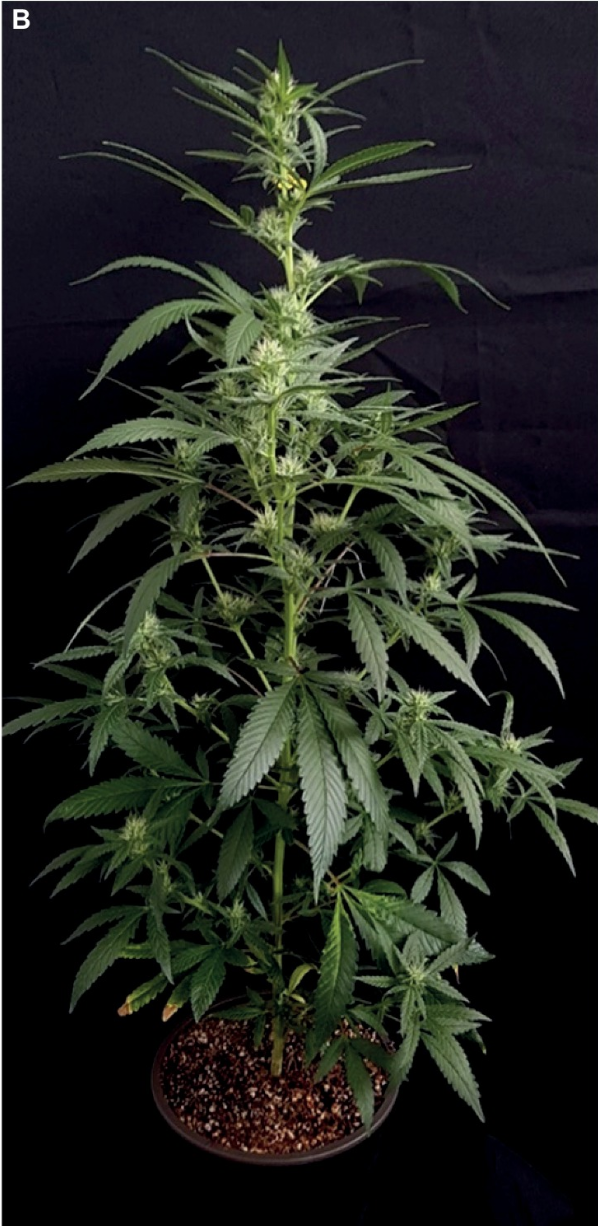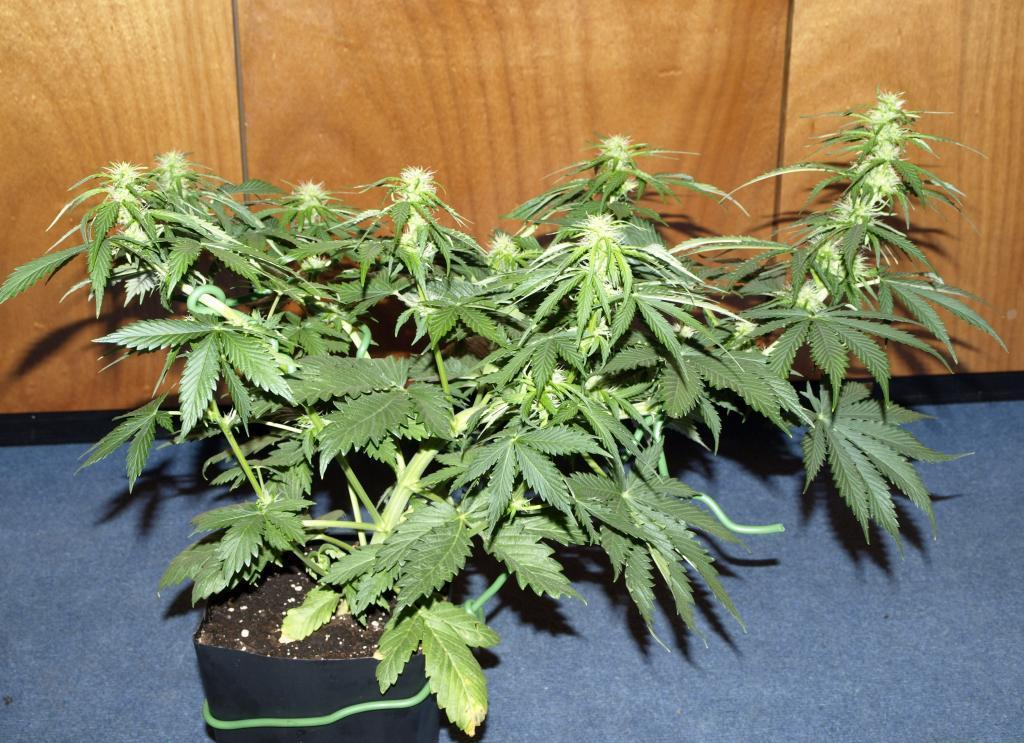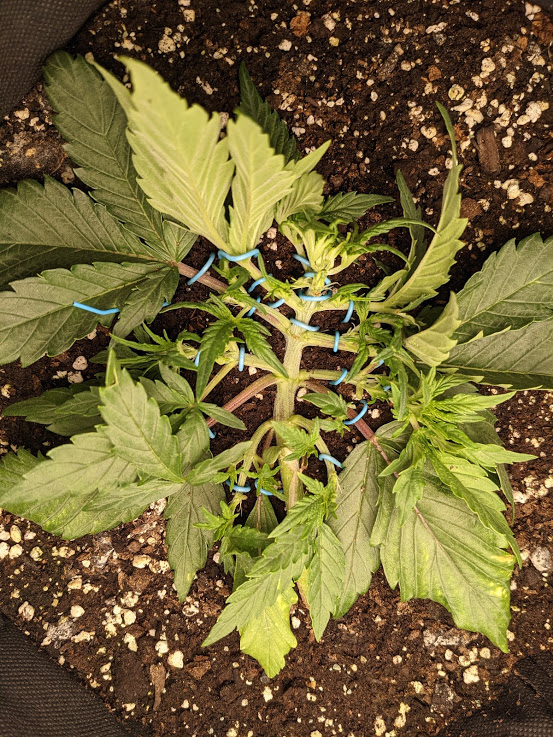Plant training: Difference between revisions
(→High Stress Techniques (HST): Added fimming) |
m (→Topology: fixed images and improved captions) |
||
| (5 intermediate revisions by the same user not shown) | |||
| Line 1: | Line 1: | ||
| − | The main concept of training a plant is to shape the canopy and stems in a way that will maximize yield. For example, without training, the upper canopy |
+ | The main concept of training a plant is to shape the canopy and stems in a way that will maximize yield. For example, without training, the upper canopy will naturally put the lower canopy in shade. Via training it is possible to force lower branches to grow away from more dense areas to receive more [[Light|light]] and [[Plant_processes#Gas_exchange|airflow]]; this allows the plant to be more open, giving each branch more growing room and a chance to branch further. |
| + | == Topology == |
||
| ⚫ | |||
| + | The topology of a plant is simply a way to describe its shape in 3D space. The natural topology for most strains of cannabis is to grow straight up and produce a single large cola. This is determined somewhat by the branching behavior which changes at different life stages<ref>Architecture and Florogenesis in Female Cannabis sativa 2019 |
||
| ⚫ | LST can be applied as soon as the plant has one node, as this is when it is flexible and not brittle. One of the |
||
| + | - http://dx.doi.org/10.3389/fpls.2019.00350</ref> By applying plant training techniques the topology can be made drastically different from the natural behavior. |
||
| + | <div align='center'> |
||
| − | It may be necessary to adjust your LST every day or every two days when the plant is growing quickly |
||
| ⚫ | |||
| + | <li style="display: inline-block;"> [[File:Natural topology.png|thumb|441x441px|Natural topology (early flowering). The vast majority of strains will naturally grow in this shape.|alt=|none]] </li> |
||
| + | <li style="display: inline-block;">[[File:Plant with LST applied.png|thumb|Plant with LST applied to form a horizontal line|alt=|none]] </li> |
||
| + | </ul> |
||
| + | </div> |
||
| + | |||
| ⚫ | |||
| ⚫ | Some forms of LST can be applied as soon as the plant has one node, as this is when it is flexible and not brittle. Things like pinning or tieing down stems. One of the most common goals when employing LST is to make the main stem grow sideways so that most of the branches aren't in the shadow of the main canopy, as they would be if the canopy was directly above. LST can be applied throughout the plant's entire lifespan. It may be necessary to adjust your LST every day or every two days when the plant is growing quickly. |
||
| + | |||
| + | === Tying branches === |
||
| + | This is the most basic form of LST and usually consists of holding a stem down with Plant wire (a metal wire coated in rubber) attached to the plant's pot; generally, this requires the grower to make holes in the side of the pot. Plant wire can also be used to move branches by tying them to other branches when the plant is more mature. String can also be used to restrain branches but very thin threads may cut into the flesh of the branch. |
||
| + | [[File:Tying to the pot.png|center|thumb|Holes have been drilled in the sides of the pot to tie branches to]] |
||
=== Fluxxing === |
=== Fluxxing === |
||
| − | + | Fluxxing is a method of using metal wire (or paper clips) to pin the stem down as it grows. This greatly reduces the height of the plant by training branches to grow laterally. This method is better suited to more compact mediums like soil, as pins require some friction to stay in place. Pinning should start as soon as there is a long enough stem to pin. You can grow a seedling in low light to increase the stem stretching in the seedling phase. This can increase the inter-nodal distance, giving your branches more space later on in flowering. If branches are pinned tightly, pins will have to be removed after the plant has adjusted so that they do not constrict or cut into growing stems. |
|
| − | <div align='center'> |
+ | <div align='center'><ul> |
| ⚫ | |||
<li style="display: inline-block;"> [[File:LST-pinning-down.png|thumb|none|300px|Here, the plant is kept low to the soil with blue paper clips. See how the clips can be used to twist the main stem as it grows so that all nodes can emerge parallel to the soil]] </li> |
<li style="display: inline-block;"> [[File:LST-pinning-down.png|thumb|none|300px|Here, the plant is kept low to the soil with blue paper clips. See how the clips can be used to twist the main stem as it grows so that all nodes can emerge parallel to the soil]] </li> |
||
| − | <li style="display: inline-block;"> |
+ | <li style="display: inline-block;"> </li> |
</ul> |
</ul> |
||
</div> |
</div> |
||
| − | |||
| − | Plant wire, a metal wire coated in rubber, can be wrapped around stems and used to hold others in place without cutting into the stem as well as being tied through holes in the side of the pot. |
||
===Ponytailing === |
===Ponytailing === |
||
| − | Ponytailing is the process of tying leaves up in a bunch together to remove the shade they create. This also leads to the ponytailed stem receiving less light and stretching more as a result. This can be done with small cable ties or paper clips. |
+ | Ponytailing is the process of tying leaves up in a bunch together to remove the shade they create. This also leads to the ponytailed stem receiving less light and stretching more as a result. This can be done with small cable ties or paper clips at any point in the plant's life. |
===Defoliating=== |
===Defoliating=== |
||
| − | Defoliating is simply the process of removing excess leaves. If there are too many leaves, the humidity can become too high and fan leaves that do not create buds can shade other branches that will bear buds. Take care not to prune excessively once the plant is a few weeks into flowering, as the leaves will not regrow, negatively impacting yield. |
+ | Defoliating is simply the process of removing excess leaves. If there are too many leaves, the humidity can become too high and fan leaves that do not create buds can shade other branches that will bear buds. Defoliation is necessary for maximizing yields and should mostly take place in the vegetative stage. Take care not to prune excessively once the plant is a few weeks into flowering, as the leaves will not regrow, negatively impacting yield. |
===Lollipopping=== |
===Lollipopping=== |
||
| − | This is the process of stripping all small buds and leaves from a branch except those at the top |
+ | This is the process of stripping all small buds and leaves from a branch except those at the top so that the branch resembles a lollipop. The idea is that the plant will spend more resources on the cola at the top of the stem, as less is wasted on small buds (sometimes referred to as "popcorn" buds) that are in the shade of the main canopy. This technique is more suited to photo-flowering strains, as they have more time to recover from the process before flowering. As an alternative to lollipopping, smaller buds can be left to continue growing after an initial harvest of the main colas, until they are mature enough for a second harvest. |
===Screen of green (ScrOG)=== |
===Screen of green (ScrOG)=== |
||
| Line 31: | Line 41: | ||
===Sea of green (SOG)=== |
===Sea of green (SOG)=== |
||
| − | A method of planting a large number of plants so that there is a high density of cultivars under a trellis. |
+ | A method of planting a large number of plants so that there is a high density of cultivars under a trellis. A ScrOG with multiple plants. |
| − | == |
+ | == High-Stress Techniques (HST)== |
===Topping=== |
===Topping=== |
||
| Line 43: | Line 53: | ||
===Mainlining === |
===Mainlining === |
||
| − | By topping the main stem, one can create a manifold ('Y' shaped stem). This forces the plant to split resources between the remaining branches, creating a more even canopy. This should be done when the plant a) has at least three nodes, b) when it is healthy and c) while it is still vegetating. After creating a manifold, LST should be applied to maintain the shape of the plant. |
+ | By topping the main stem, one can create a manifold ('Y' shaped stem). This forces the plant to split resources between the remaining branches, creating a more even canopy. This should be done when the plant a) has at least three nodes, b) when it is healthy and c) while it is still vegetating. After creating a manifold, LST should be applied to maintain the shape of the plant.[[File:Tall fluxing.jpg|thumb|421x421px|This example shows a manifold in the centre and the stem being kept parallel to the soil by garden wire|alt=|center]] |
| + | == References == |
||
Latest revision as of 12:05, 26 December 2022
The main concept of training a plant is to shape the canopy and stems in a way that will maximize yield. For example, without training, the upper canopy will naturally put the lower canopy in shade. Via training it is possible to force lower branches to grow away from more dense areas to receive more light and airflow; this allows the plant to be more open, giving each branch more growing room and a chance to branch further.
Topology
The topology of a plant is simply a way to describe its shape in 3D space. The natural topology for most strains of cannabis is to grow straight up and produce a single large cola. This is determined somewhat by the branching behavior which changes at different life stages[1] By applying plant training techniques the topology can be made drastically different from the natural behavior.
Low-Stress Techniques (LST)
Some forms of LST can be applied as soon as the plant has one node, as this is when it is flexible and not brittle. Things like pinning or tieing down stems. One of the most common goals when employing LST is to make the main stem grow sideways so that most of the branches aren't in the shadow of the main canopy, as they would be if the canopy was directly above. LST can be applied throughout the plant's entire lifespan. It may be necessary to adjust your LST every day or every two days when the plant is growing quickly.
Tying branches
This is the most basic form of LST and usually consists of holding a stem down with Plant wire (a metal wire coated in rubber) attached to the plant's pot; generally, this requires the grower to make holes in the side of the pot. Plant wire can also be used to move branches by tying them to other branches when the plant is more mature. String can also be used to restrain branches but very thin threads may cut into the flesh of the branch.
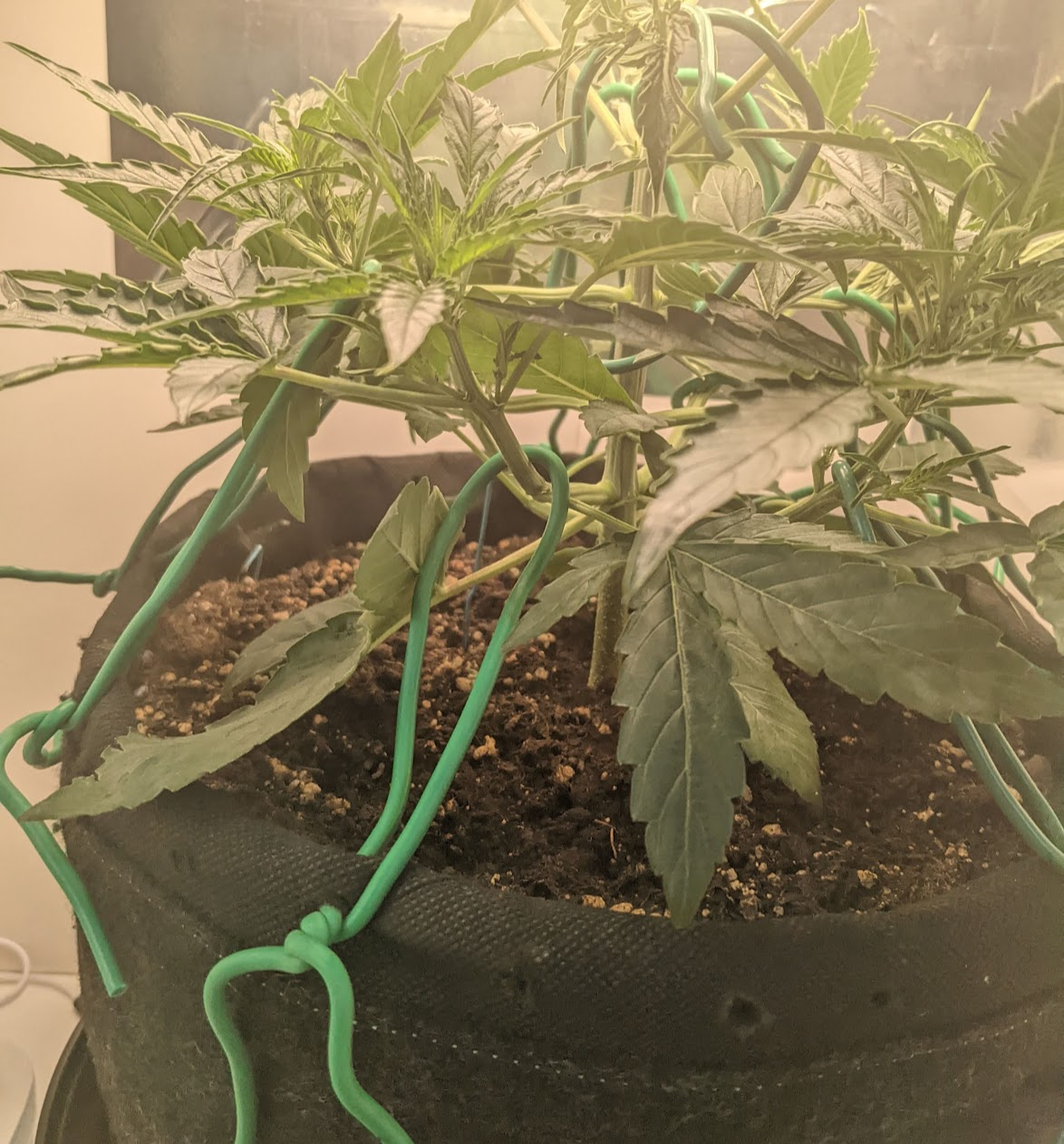
Fluxxing
Fluxxing is a method of using metal wire (or paper clips) to pin the stem down as it grows. This greatly reduces the height of the plant by training branches to grow laterally. This method is better suited to more compact mediums like soil, as pins require some friction to stay in place. Pinning should start as soon as there is a long enough stem to pin. You can grow a seedling in low light to increase the stem stretching in the seedling phase. This can increase the inter-nodal distance, giving your branches more space later on in flowering. If branches are pinned tightly, pins will have to be removed after the plant has adjusted so that they do not constrict or cut into growing stems.
Ponytailing
Ponytailing is the process of tying leaves up in a bunch together to remove the shade they create. This also leads to the ponytailed stem receiving less light and stretching more as a result. This can be done with small cable ties or paper clips at any point in the plant's life.
Defoliating
Defoliating is simply the process of removing excess leaves. If there are too many leaves, the humidity can become too high and fan leaves that do not create buds can shade other branches that will bear buds. Defoliation is necessary for maximizing yields and should mostly take place in the vegetative stage. Take care not to prune excessively once the plant is a few weeks into flowering, as the leaves will not regrow, negatively impacting yield.
Lollipopping
This is the process of stripping all small buds and leaves from a branch except those at the top so that the branch resembles a lollipop. The idea is that the plant will spend more resources on the cola at the top of the stem, as less is wasted on small buds (sometimes referred to as "popcorn" buds) that are in the shade of the main canopy. This technique is more suited to photo-flowering strains, as they have more time to recover from the process before flowering. As an alternative to lollipopping, smaller buds can be left to continue growing after an initial harvest of the main colas, until they are mature enough for a second harvest.
Screen of green (ScrOG)
ScrOG or Screen of Green is a training method where a large trellis (a.k.a mesh, screen, net) is placed over the cultivar so that the branches can be more easily shaped to form a flat canopy. This technique is often paired with mainlining.
Sea of green (SOG)
A method of planting a large number of plants so that there is a high density of cultivars under a trellis. A ScrOG with multiple plants.
High-Stress Techniques (HST)
Topping
Removing the growth at the top of a branch. This can be used to create two new heads at the top of the branch.
Fimming
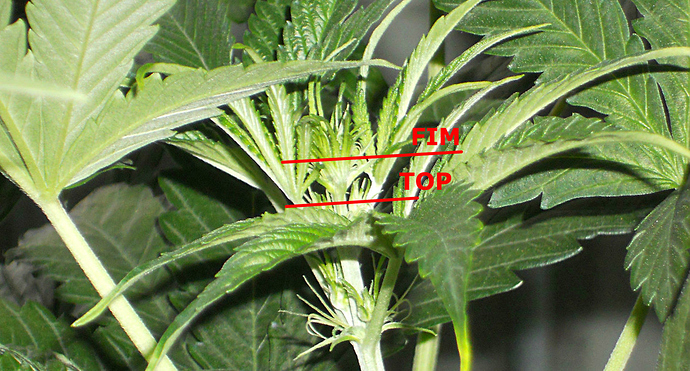
Similar to topping but the cut is made slightly higher up the stem. This results in 4 branches growing from the cut.
Mainlining
By topping the main stem, one can create a manifold ('Y' shaped stem). This forces the plant to split resources between the remaining branches, creating a more even canopy. This should be done when the plant a) has at least three nodes, b) when it is healthy and c) while it is still vegetating. After creating a manifold, LST should be applied to maintain the shape of the plant.
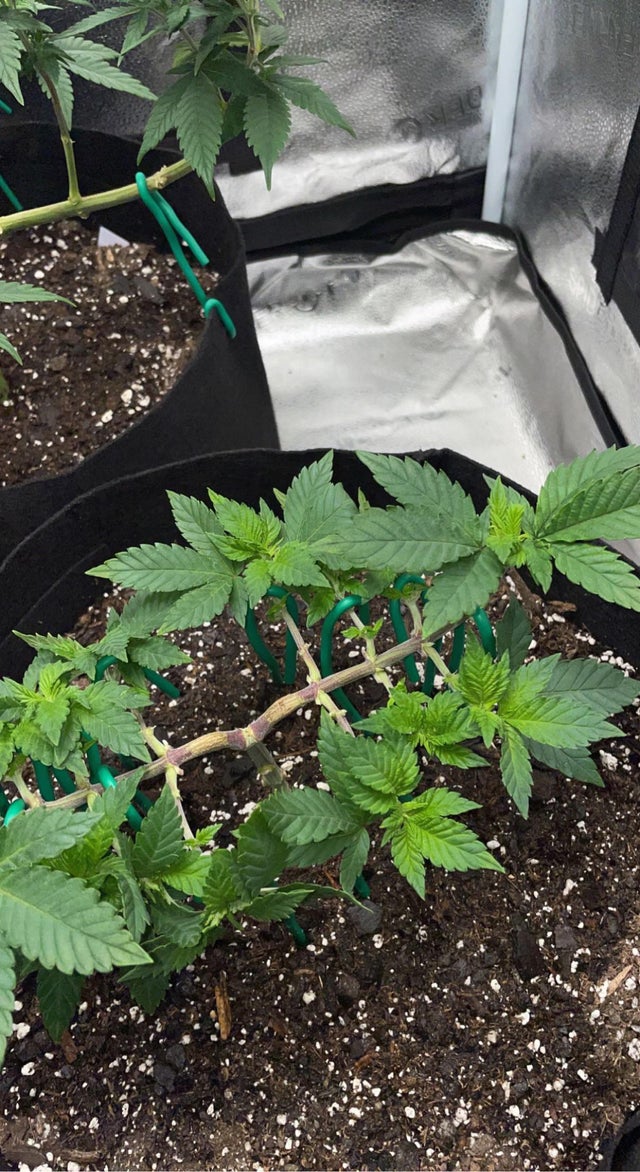
References
- ↑ Architecture and Florogenesis in Female Cannabis sativa 2019 - http://dx.doi.org/10.3389/fpls.2019.00350
